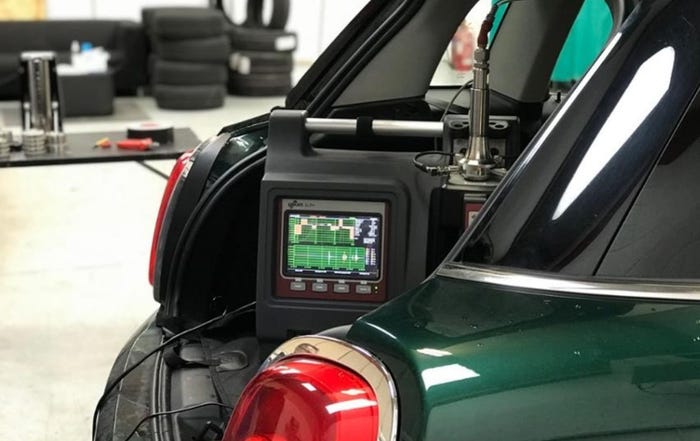Great Expectations
SCOTTSDALE, AZ The skepticism hung in the air of this desert town. And it was Bob Lutz's fault. General Motors Corp.'s vice chairman-product development told the media in November that the forthcoming '04 Pontiac Grand Prix is the best performance sedan, certainly for a domestic, that I've ever driven anywhere (and) that I've ever driven at this price point. Eyes rolled. The whispers started. After
March 1, 2003

SCOTTSDALE, AZ — The skepticism hung in the air of this desert town. And it was Bob Lutz's fault. General Motors Corp.'s vice chairman-product development told the media in November that the forthcoming '04 Pontiac Grand Prix “is the best performance sedan, certainly for a domestic, that I've ever driven anywhere (and) that I've ever driven at this price point.”
Eyes rolled. The whispers started.
After waiting two months, it was time to see if the automotive legend had retained his credibility. The answer is: maybe, which shouldn't disappoint GM. The fact that Lutz's claim can't be definitively dismissed makes the car a resounding success.
The '04 Grand Prix features the same platform and engine as the outgoing model, the MS2000 architecture and 3.8L V-6 powerplant. GM has pulled off what its competitors — namely the Japanese — have been doing for years: engineering a quantum evolution of an existing platform rather than developing an entirely new undercarriage. The new Grand Prix has 80% new parts.
On a daylong drive from the Valley of the Sun to the mountains of Sedona, the sedan is very compliant, especially for a car priced from $21,760 to $27,255, not including destination charges. Bounce is minimal from road swells. Grand Prix's WideTrack Handling system, standard on both models — GT and GTP — harmonizes the car's suspension, steering, brakes and other chassis components. The base GT offers 200 hp (the same output as in '02) and a top speed of 108 mph (174 km/h) — getting roughly half the way there in 8.5 seconds. Alas, GM's venerable 3.8L finally appears to be showing signs of age. A noticeable rasp accompanies acceleration, which is weak when attempting to pass at highway speeds. This iron pushrodder is getting clunky. For the GTP model, the powerplant is equipped with a fifth-generation Eaton supercharger. That improves horsepower to 260 and reduces 0-60 mph (97 km/h) acceleration to 6.5 seconds, GM says. However, high-end torque remains unimpressive. While respectable, the 3.8L is no match for Nissan Maxima's all-aluminum 3.5L dual-overhead-cam V-6.
The Grand Prix engine is mated to a 4-speed automatic transmission. No manual gearbox is available, mainly because GM doesn't have one capable of managing the torque. Instead, the auto maker offers its TAPshift technology on the GTP's Competition Group package. The top-of-the-line model features “clutchless” shifting. Paddles positioned on each side of the steering wheel are used to change gears. It's fun initially. But with only four speeds available, TAPshift's potential is stunted. There also is a perceptible delay when downshifting from fourth to third.
Grand Prix's exterior design is where Pontiac should be heading.
Pontiac needs to move away from its eccentric past, but it overreacted and designed a lackluster GTO that fails to pay homage to the original. Grand Prix is a better compromise. Smooth creases and grooves resemble an ice sculpture. The Intrigue-like tail could have been lifted from sketches out of the defunct Oldsmobile design studio. Grand Prix's rear also hints of Audi. The nose is unmistakably Pontiac. But nothing about Grand Prix seems to draw much attention from other motorists.
To get inside, swing open the rear doors to 82 degrees (compared to 67 degrees on the previous model). That's nearly perpendicular to the B-pillar. It makes getting in and out and loading big boxes or bulky items a lot easier. Rear seats fold down 60/40. With the optional fold-flat front passenger seat, items 9-ft. (2.7 m) long can be carried inside. Seats are comfortable and embrace shoulders and hips.
The driver-orientated gauges are crisp and jumbo-sized. Satin nickel tastefully accents the steering wheel. Atop the center stack is a well-executed arrangement of five buttons that operate a digital readout offering travel information, outside temperature, compass and date. However, during our Arizona test drive on a sunny day in late January, the Driver Information Center display couldn't be read without cupping the readout to provide shade. That needs to be fixed.
The chunky, scuba gear-like stereo buttons, which still curse many other GM models, are used on the Grand Prix GT. They detract from an otherwise attractive interior, even though the dashboard vents look like they belong on the Millennium Falcon. That's probably not what Bob Lutz had in mind when he praised Grand Prix. But he does like to fly.
Read more about:
2003About the Author
You May Also Like



